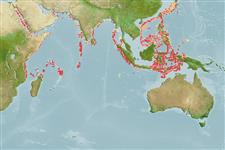Environment: milieu / climate zone / depth range / distribution range
Écologie
marin benthopélagique; profondeur 250 - 350 m (Ref. 6181). Deep-water; 31°N - 14°S, 32°E - 139°E (Ref. 6181)
Western Indian Ocean: Red Sea and west coast of India. Western Pacific: Timor Sea. This species has long been synonymized with Trichiurus lepturus.
Taille / Poids / Âge
Maturity: Lm ? range ? - ? cm
Max length : 42.4 cm TL mâle / non sexé; (Ref. 6181); common length : 23.0 cm TL mâle / non sexé; (Ref. 6181)
Épines dorsales (Total) : 3; Rayons mous dorsaux (Total) : 106 - 116; Rayons mous anaux: 80. Body extremely elongate, compressed and tapering to a point. Mouth very large with a small dermal process at the tip of each jaw. Pelvic and caudal fins absent. Lateral line originating at the upper margin of the gill cover, running obliquely to behind the tip of the pectoral fins, then parallel to the ventral contour of the body. Fresh specimens are pearl white and slightly dusky dorsally; the margins of the dorsal and anal fins dusky in formalin.
Found in deep waters off Kerala and Tamil Nadu, India. Feeds on deep water shrimps and small fishes like myctophids and gonostomatids. Caught with deep water trawls mixed together with other commercially important fish as bycatch.
Life cycle and mating behavior
Maturities | Reproduction | Spawnings | Egg(s) | Fecundities | Larves
Nakamura, I. and N.V. Parin, 1993. FAO Species Catalogue. Vol. 15. Snake mackerels and cutlassfishes of the world (families Gempylidae and Trichiuridae). An annotated and illustrated catalogue of the snake mackerels, snoeks, escolars, gemfishes, sackfishes, domine, oilfish, cutlassfishes,. scabbardfishes, hairtails, and frostfishes known to date. FAO Fish. Synop. 125(15):136 p. (Ref. 6181)
Statut dans la liste rouge de l'IUCN (Ref. 130435)
Menace pour l'homme
Harmless
Utilisations par l'homme
Pêcheries: sans intérêt
Outils
Articles particuliers
Télécharger en XML
Sources Internet
Estimates based on models
Preferred temperature (Ref.
123201): 11 - 21.8, mean 12.2 °C (based on 49 cells).
Phylogenetic diversity index (Ref.
82804): PD
50 = 0.5020 [Uniqueness, from 0.5 = low to 2.0 = high].
Bayesian length-weight: a=0.00191 (0.00078 - 0.00466), b=3.11 (2.90 - 3.32), in cm total length, based on LWR estimates for this (Sub)family-body shape (Ref.
93245).
Niveau trophique (Ref.
69278): 4.2 ±0.73 se; based on food items.
Résilience (Ref.
120179): Faible, temps minimum de doublement de population : 4,5 à 14 années (Assuming tmax>10).
Fishing Vulnerability (Ref.
59153): Low to moderate vulnerability (32 of 100).
Nutrients (Ref.
124155): Calcium = 167 [42, 435] mg/100g; Iron = 0.939 [0.262, 3.001] mg/100g; Protein = 17.7 [15.9, 19.6] %; Omega3 = 0.285 [0.122, 0.695] g/100g; Selenium = 57.5 [16.1, 220.8] μg/100g; VitaminA = 5.47 [0.58, 46.73] μg/100g; Zinc = 0.834 [0.382, 1.501] mg/100g (wet weight);
